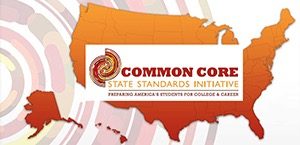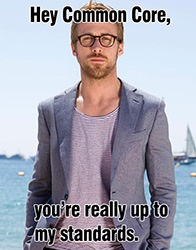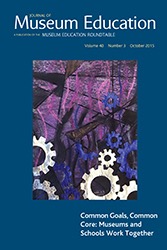Common Core? Oh, we go waaaay back: A Museum Educator’s long-term relationship with standards
Deciding what to write about for this post that wouldn’t recycle much of what has already been said about the Common Core, I kept circling back to something my professor Roberta Altman told me in a graduate course at Bank Street College, circa 2001. She said something like, “Design a creative, lively lesson with all of your best teaching strategies and then you can go through the standards and check off those it addresses. Don’t start with the checklist or you’ll be crafting a lesson constrained by them.” Frankly, as a pretty devout rule-follower, this get-out-of-jail-free card was huge for me. Only now, looking back on my experiences with school audiences, am I so acutely aware of the impact Roberta’s words had on my teaching practice.
I decided to reach out to Roberta to see what, if anything, about her approach to “Standards” has changed (and to verify what I thought she had to say about them all those years ago). She replied:
“I still hold to writing your own lesson plans first. Not everyone gets rigorous and thorough training in curriculum development and the way it intersects with child development and content. One of the goals of the CCSS is to insure a minimum level of good teaching. At the same time, teachers are professionals and should be respected for their ability to create their own lessons. I still think that teachers should try their hand at it at first. Then see both what matches in the CCSS and what they could add. The CCSS are a much better set of standards than the ones available at the time you were going through Bank Street. The main problem is the way that they are being implemented so rigidly and uncreatively.” (1)
 All that to say, when I first heard rumblings about the Common Core, I didn’t panic. I was confident my methodology was solid, but I knew I needed to get up to speed with them quickly, as well as find out what teachers were saying. At the time, I was head of K-12 programs at the Brooklyn Museum, so I reached out to Jody Madell, a trusted colleague from one of our partnership schools to come and share what she knew with my staff. She gave us the lowdown on the planned instructional shifts and provided some examples of changes the kids could expect to see on assessments.
All that to say, when I first heard rumblings about the Common Core, I didn’t panic. I was confident my methodology was solid, but I knew I needed to get up to speed with them quickly, as well as find out what teachers were saying. At the time, I was head of K-12 programs at the Brooklyn Museum, so I reached out to Jody Madell, a trusted colleague from one of our partnership schools to come and share what she knew with my staff. She gave us the lowdown on the planned instructional shifts and provided some examples of changes the kids could expect to see on assessments.
Okay, maybe I panicked a little.
The changes were definitely big enough to keep digging. In October 2011, I helped put together the monthly program, “Museums and the Common Core: What’s Your Role?” for the New York City Museum Educators Roundtable (NYCMER). It’s humorous to read the blog post now and remember how cool we thought we were to be live-tweeting, but the “elevator speech” we came up with is a time capsule of our optimistic attitude about our emerging roles. There was no question our work in museums was compatible and we were quite taken with how we could ensure the implementation was a success.
 In October 2012, NYCMER organized (and videotaped) “Getting to the Core of the Common Core,” which was a deep dive into the year’s instructional shifts in ELA: Rigor and Text Complexity. Presenter Rhonda Jenkins, a literacy consultant involved in the implementation of the National Literacy Standards in the UK, assured us that what seemed like a lengthy roll-out was pretty typical of large-scale initiatives, pointing to the ten years it took in the UK. She added: “One of the challenges in schools, is of course that the government wants to see results right away.” This is certainly true here in the U.S.
In October 2012, NYCMER organized (and videotaped) “Getting to the Core of the Common Core,” which was a deep dive into the year’s instructional shifts in ELA: Rigor and Text Complexity. Presenter Rhonda Jenkins, a literacy consultant involved in the implementation of the National Literacy Standards in the UK, assured us that what seemed like a lengthy roll-out was pretty typical of large-scale initiatives, pointing to the ten years it took in the UK. She added: “One of the challenges in schools, is of course that the government wants to see results right away.” This is certainly true here in the U.S.
It’s now October 2015 and according to Rhonda’s timeline, we’re about halfway through the metamorphosis. But Common Core is still front page news. This month, in the very same week, President Obama finally called for a limit on hours spent testing and New York State’s Education Department announced it is conducting a survey in order to provide an opportunity for the public to comment on the standards.
However, stats from education writer Kimberly Hefling indicate the standards have become a reality for roughly 40 million students, or about four out of five public school kids. Even Common Core critic Neal McCluskey of the Cato Institute agrees that the standards are likely here to stay, conceding, “My sense is that most states are going to officially stay with Common Core or something like it.” Psychologist and educator Thom Markham opines, “Sooner or later, inquiry-standards will take precedence over content-based standards. The shift into the next, non-industrial phase of schooling is a psychological issue, not just a logistical one. It’s happening, whether we agree or not.” (2)
Let’s consider what’s next. Some “strategery,” if you will. Futurist Elizabeth Merritt’s crystal ball reveals signs that, “the U.S. is nearing the end of an era in formal learning characterized by teachers, physical classrooms, age-cohorts and a core curriculum—what some people call the industrialized era of learning,” and predicts, “the next era of education will be characterized by self-directed, experiential, social and distributed learning that is designed to foster the 21st-century skills of critical thinking, synthesis of information, innovation, creativity, teamwork and collaboration.”
Sound familiar?
There’s still a critical role for museums in such a future, “both as resources for learners, and as teachers of teachers, sharing what they have learned from their last century of education.” (3)

The Common Core? Oh, we go way back. My advice for long-term relationships with standards?
- Be informed, but don’t get lost in the minutiae.
- Know what you do best and how to talk about it.
- Value teachers as collaborators.
- Keep thinking creatively.
And don’t be surprised when another set of standards arrive on the scene. In the meantime, be sure to read the current issue of the Journal of Museum Education: Common Goals, Common Core. There’s also a companion Reader Guide (written by yours truly with others on the MER board) that will help you unpack more about your own relationship to the Common Core.
Alexa Fairchild is the local program director for Turnaround Arts: New York City, a White House initiative using the arts to create success in struggling schools. For ten years, she ran school programs at the Brooklyn Museum. She serves on the board of the Museum Education Roundtable and as a peer reviewer for the Journal of Museum Education. She tweets as @alexainbrooklyn.
Citations: 1) Personal Communication, October 2015; 2) Inquiry Learning vs. Standardized Content: Can They Coexist?; 3) Building the Future of Education.

